2025 Annual General Meeting
Our 2025 AGM was held on March 27th at Christ Church Centre, Reading Road, Henley on Thames.
Please see the link below to the Draft Minutes.
Our 2025 AGM was held on March 27th at Christ Church Centre, Reading Road, Henley on Thames.
Please see the link below to the Draft Minutes.
Living, as we do, in an area with three-tiered local government we often find that residents are confused regarding which Authority is responsible for which service.
We have, therefore, attempted to list under each Authority the areas for which they are responsible. We believe we have covered the important items but our website does provide a direct link to each Authorities website should further clarification be necessary. We trust that you will find this page useful.
What are the responsibilities of Henley Town Council?
What are the responsibilities of South Oxfordshire District Council?
What are the responsibilities of Oxfordshire County Council?

Following our enjoyable outing on the Kennet & Avon Canal on a horse drawn barge we thought members might like a brief history of the Canal itself.
The Kennet and Avon Canal is a historic waterway in southern England. It was originally constructed in the late 18th century as a navigation route between the cities of Bristol and London. The canal spans a distance of 87 miles (140 kilometers) and connects the River Kennet in Reading with the River Avon in Bath. Construction of the Kennet and Avon Canal began in 1794 and took several years to complete. It was designed to provide a direct link between the industrialized regions of the Midlands and the major ports of Bristol and London. The canal was also intended to serve as a transportation route for goods such as coal, timber, and agricultural produce. The canal’s construction was a major engineering feat of its time, involving the excavation of numerous locks, tunnels, and aqueducts. One of its most notable features is the Caen Hill Locks, a flight of 29 locks near Devizes that allows boats to ascend or descend a steep hillside. These locks are considered a remarkable example of Georgian canal engineering. During the 19th century, the Kennet and Avon Canal flourished as a vital trade route, bringing economic prosperity to the towns and villages along its course. However, with the advent of railways in the mid-19th century, the canal’s commercial importance declined. By the early 20th century, the canal had fallen into disrepair and was largely abandoned. In the latter half of the 20th century, efforts were made to restore and reopen the Kennet and Avon Canal for recreational use. The restoration project was a significant undertaking, requiring extensive repairs and the rebuilding of many structures. Today, the canal is a popular destination for boating, walking, and cycling, attracting both locals and tourists who appreciate its scenic beauty and historical significance. The Kennet and Avon Canal stands as a testament to the ingenuity and vision of its original builders, and its rich history continues to be cherished and enjoyed by people from all walks of life.
One of the most frequently asked questions of our Executive Committee is ‘what does the Henley Society actually do?’
And so in the spirit of informing, we list below our activities, both successful and not so much so, from the start of 2020.
2025
2020 to end 2024
Whilst carrying out this work we have expanded our membership from 253 to over 680 and maintained our annual and life subscription rates at prices set in 1993
Following the recent partial restoration of the Pest House at Townlands Hospital the Henley Society has had sited alongside the building, a plaque explaining the purpose of the building and some of its history.
The Pest House, now Grade 11 listed, was the isolation unit for the nearby workhouse and was used to house inmates carrying infectious diseases.
For a week in 1794 the Pest House held a certain Silas Tomkyn Cumberbache who had fled Cambridge University in the face of a huge debt built up as a result of his taste for drugs, drink and women.
He joined the Light Dragoons based in Reading only for it to be discovered that he was totally incapable of riding a horse. He was therefore assigned to look after a fellow recruit who had caught smallpox, and Cumberbache and his charge ended up in the foul conditions of the Pest House for eight days and nights. Cumberbache turned out to be none other than Samual Taylor Coleridge the poet (The Rime of the Ancient Mariner.)
He found his stay a miserable experience about which he later wrote. and by which his later work was influenced.
Geoff Luckett. the Society’s Chairman said that ‘this interesting piece of Henley’s rich history should be preserved and hence the Society’s wish to commemorate it,’
The plaque includes two QR codes one of which directs you to the Society web site and the other to the Assendon on-line Museum for more information.
Our 2024 AGM was held on March 21st at Shiplake Memorial Hall.
Please see the links below to the Draft Minutes and a transcript of the speech delivered to the meeting by the Deputy Mayor Cllr Rory Hunt.
Speech by Cllr Rory Hunt, Deputy Henley Mayor
This is a short story about one local turnpike. At one time there were three turnpikes around Henley; one to Hurley and Maidenhead, one to Dorchester and Oxford and one, the subject of this article, which went through Henley from Hatfield to Reading.
The route of the Hatfield Reading Turnpike
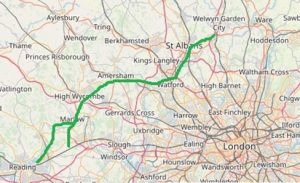
Where did this start? In the 16c, an Act of Parliament made parishes responsible for the upkeep of highways within their boundaries. This system was sufficient to maintain the local roads in many rural parishes, but where parishes had major highways passing through, it proved inadequate. The vehicles that damaged the roads were from other parishes, especially major stagecoach routes. So parish residents did not benefit nor had the necessary resources. As a result, some major highways became quagmires barely passable in winter.
In the early 18c, to reduce this burden on parishes, the first turnpike trusts were set up, each by Act of Parliament. These gave powers locally to collect road tolls for maintaining the major highways. By the 1830s, over 1,000 trusts administered around 30,000 miles of turnpike road in England & Wales, taking tolls at almost 8,000 toll-gates.
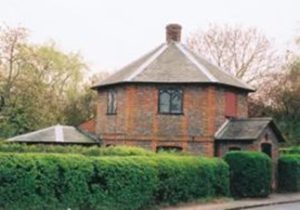
Toll House in Tidmarsh near Pangbourne
The term turnpike had originated from the military practice of placing a pikestaff across a road to block and control passage. Upon payment of the toll, the pike would be “turned” to one side to allow travellers through.
The new turnpikes were administered directly by the local justices of the peace. The trustees could erect gates as they saw fit, demand labour or a cash equivalent, and appoint surveyors and collectors. In return, they repaired the road and erected mileposts. The expectation was that the trust would borrow the money to repair the road and repay that debt over time with the road then reverting to the parishes. In reality, the initial debt was rarely paid off and the trusts were renewed as needed.
‘Gout Track’
One of the less likely routes set up was the ‘Hatfield and Reading Turnpike’, nicknamed the ‘Gout Track’. It was created in the 1760s to provide a route that connected the Great North Road (the modern A1) with the Holyhead Road (A5) and the Bath Road (A4). By 1881 it was one of the last of the turnpikes to have its tolls removed.
It is said that the Marquis of Salisbury, who lived at Hatfield House, wanted a route to the Great West Road that avoided central London, giving onward access to the spa towns of Bath and Cheltenham where, as a sufferer of gout, he often took the waters. This would also spare him the discomfort and congestion of London’s cobbled streets. With the Earl of Essex, who suffered from a similar affliction, and others, they sponsored an Act of Parliament passed in 1757 for the building of a road from Hatfield to Reading. Then the Reading and Hatfield Turnpike Trust was set up by a further Act passed in 1768. The turnpike ran from Hatfield through St Albans, Watford, Rickmansworth, Agmondesham (now Amersham), High Wycombe and Marlow, thence splitting to access the Great West Road; one at Knowl Hill and the other at Reading, that through Henley-on-Thames; in all some 50 miles.
The Trust lasted until 1881 and was one of the last Turnpike Trusts operating in the country. Analysis of toll receipts shows that traffic was lighter than on the great trunk routes it was connected to. Nevertheless, it stimulated the local economies along its route in trades like farriers, foraging and inn keeping.
The end of the Turnpikes
Many turnpike trusts were wound up under General Acts of Parliament between 1873 and 1878. The transfer of resources and sale of assets to repay loans were supervised by the Local Government Board which acted as arbiter in the case of disputes. Toll-houses were sold, gates torn down and responsibility for the main roads passed to Highway Boards. Bond-holders were paid off with any residual funds, though some did not get a satisfactory return on their investment
Under the Highways Act of 1878 all ‘disturnpiked’ roads became “Main Roads” as did some ordinary highways. By the Local Government Act 1888 the entire maintenance of main roads was passed to County Councils.
Structure of Turnpike Acts
The powers granted to a turnpike trust were viewed with suspicion. In effect the trustees were given powers to charge for use of an existing resource, the highway. Unlike the later canals and railway builders they were not creating a new facility and so their rights were restricted. Powers were only granted for a specific length of time and the trusts were not expected to make a profit, merely raise and use sufficient money to improve and maintain the road. Each trust was empowered through an individual Act of Parliament that closely specified what the trustees were permitted to undertake to achieve their objectives. Most acts contained a long list of those who were exempt from tolls. Exemptions fell into a number of categories; e.g. local farmers going about their husbandry tasks, officials and the military on county or national business, religious observance, voting, those involved in road maintenance and then groups who had negotiated concessions to permit the particular Act to pass.
What is left today?
Most milestones and toll houses have long disappeared.
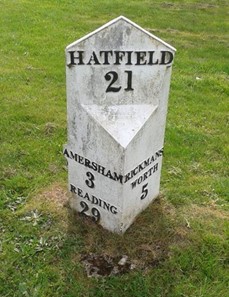
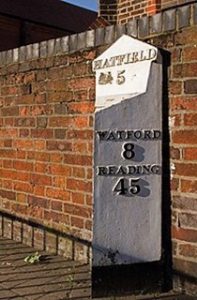
Hatfield Road
St Albans
Little Chalfont
Road classification by the newly formed Ministry of Transport in 1922, saw the route form parts of:
A414 – Hatfield to St Albans
A412 – St Albans – Watford – Rickmansworth
A404 – Rickmansworth – Amersham
A416 – Amersham – High Wycombe – Marlow – Knowl Hill
A32 – Marlow – Henley – Reading
Later, in 1935, the A404 was extended along the A416 section between Amersham and the A4 making it easier for those who wanted to use the route. The A32 section through Henley was renumbered the A4155 (later the A32 started south from Riseley but now it starts at Alton).
Administering such a long road through three counties through one body was problematic and so the 1829 Act specified three Districts. The First District ran from the north end of Caversham Bridge, being the boundary of the Borough of Reading, to the Three Horse Shoes in Henley and from Henley turnpike road near the Bell Inn to the SW corner of a barn on Thomas Wethered’s land entering Marlow. It then also covered the road from Marlow Bridge to the 31 mile-stone on the Maidenhead Turnpike. The second and third Districts covered the remainder of the turnpike to Hatfield.
Local relics
The book ‘Henley-on-Thames – A History’ by David C Whitehead refers to the turnpike. Elsewhere, there is recorded that on the road between Caversham and Henley there was a gate just south of Henley town and another further north of the town where the river turns east at Greenlands. A gate was placed on the main road at Marlow. Another gate in the village of Bisham controlled the road over Marlow Bridge towards the Maidenhead Road.
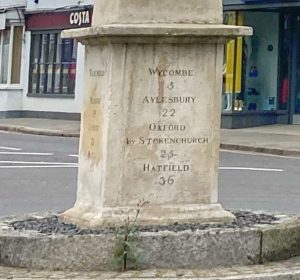
Obelisk in centre of Marlow, possible to be relocated
Nearby, it is understood that milestones can still be found at Chenies, Little Chalfont, Medmenham, Greenlands, and Burchett’s Green. Also, there is alleged to be the remains of a toll-house just south of Henley. All waiting for some local research!
Angus Ross for Henley Society
November 2023
News revealed recently in the Henley Standard, of the redevelopment of Thames Bridge House alongside the Regatta HQ, took us by surprise as we were not aware of the application. This was because the relevant Planning Authority is Wokingham Borough Council not SODC and we did not therefore receive notification of the proposal. We are hoping that we have ‘plugged’ this gap by requesting that WBC advise us of new planning applications in Remenham Parish.
Henley Town Council, at its meeting on 8 December 2022, agreed to adopt the Joint Henley and Harspden Neighbourhood Plan Review covering the years 2020-2035, replacing the previous 2016 Plan.
Download the plan here.